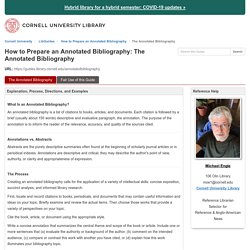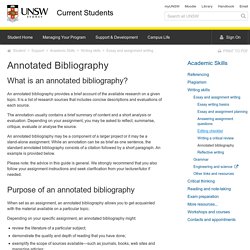

The Annotated Bibliography - How to Prepare an Annotated Bibliography - LibGuides at Cornell University. What Is an Annotated Bibliography?

An annotated bibliography is a list of citations to books, articles, and documents. Each citation is followed by a brief (usually about 150 words) descriptive and evaluative paragraph, the annotation. The purpose of the annotation is to inform the reader of the relevance, accuracy, and quality of the sources cited. Annotations vs. Abstracts Abstracts are the purely descriptive summaries often found at the beginning of scholarly journal articles or in periodical indexes. The Process Creating an annotated bibliography calls for the application of a variety of intellectual skills: concise exposition, succinct analysis, and informed library research. First, locate and record citations to books, periodicals, and documents that may contain useful information and ideas on your topic. Cite the book, article, or document using the appropriate style. Write a concise annotation that summarizes the central theme and scope of the book or article.
Annotated Bibliography. What is an annotated bibliography?

An annotated bibliography provides a brief account of the available research on a given topic. It is a list of research sources that includes concise descriptions and evaluations of each source. The annotation usually contains a brief summary of content and a short analysis or evaluation. Depending on your assignment, you may be asked to reflect, summarise, critique, evaluate or analyse the source. An annotated bibliography may be a component of a larger project or it may be a stand-alone assignment.
Please note: the advice in this guide is general. Purpose of an annotated bibliography When set as an assignment, an annotated bibliography allows you to get acquainted with the material available on a particular topic. Depending on your specific assignment, an annotated bibliography might: Questions to consider You need to consider carefully the texts that you select for your annotated bibliography. What topic/problem am I investigating? Prefect Bunker. Home - Literature Review - Library Resource Guides at Charles Sturt University. What are deepfakes – and how can you spot them?
What is a deepfake?

Have you seen Barack Obama call Donald Trump a “complete dipshit”, or Mark Zuckerberg brag about having “total control of billions of people’s stolen data”, or witnessed Jon Snow’s moving apology for the dismal ending to Game of Thrones? Answer yes and you’ve seen a deepfake. The 21st century’s answer to Photoshopping, deepfakes use a form of artificial intelligence called deep learning to make images of fake events, hence the name deepfake.
Want to put new words in a politician’s mouth, star in your favourite movie, or dance like a pro? Then it’s time to make a deepfake. What are they for? Many are pornographic. Is it just about videos? No. Audio can be deepfaked too, to create “voice skins” or ”voice clones” of public figures. How are they made? University researchers and special effects studios have long pushed the boundaries of what’s possible with video and image manipulation. It takes a few steps to make a face-swap video. Who is making deepfakes? Not at all.
Tips for undertaking the Research Project. Research Processes A4 booklet. Great places to go for research. Capabilities. Producing the Outcome. Google Trust Project: Help Identify Trustworthy News. In an effort to help with weed out fake news stories and make sure their news results, and core search results, are correct - they announced they are working with the Trust Project to help publishers use "eight trust indicators that newsrooms can add to their content.
" The eight indicators include: This is on top of the new publisher knowledge card added the other week and on top of Google's project owl and the news tweaks they made several months ago. This will supposedly work with schema and markup, but it is not clear how small or any publisher not part of the initial test bed of 10 or so publishers will work with this. I suspect over time, Google will communicate with publishers how to markup their content to hit all eight points above. Although, I still don't know how this will solve the bigger issue exactly. Google explained: News publishers embed markup from schema.org into the HTML code of their articles and on their website. We will see how this works over time... Question to spark critical thinking. How to undertake a source analysis.